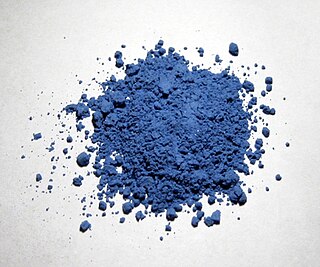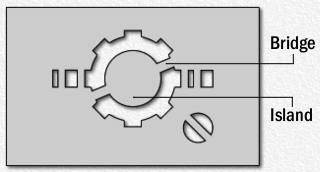
Acrylic paint is a fast-drying paint made of pigment suspended in acrylic polymer emulsion. Acrylic paints are water-soluble, but become water-resistant when dry. Depending on how much the paint is diluted with water, or modified with acrylic gels, mediums, or pastes, the finished acrylic painting can resemble a watercolor, a gouache or an oil painting, or have its own unique characteristics not attainable with other media.

Black is the darkest color, the result of the absence or complete absorption of visible light. It is an achromatic color, a color without hue, like white and gray. It is often used symbolically or figuratively to represent darkness, while white represents light. Black and white have often been used to describe opposites such as good and evil, the Dark Ages versus Age of Enlightenment, and night versus day. Since the Middle Ages, black has been the symbolic color of solemnity and authority, and for this reason is still commonly worn by judges and magistrates, including the justices of the U.S. Supreme Court.

Ink is a liquid or paste that contains pigments or dyes and is used to color a surface to produce an image, text, or design. Ink is used for drawing or writing with a pen, brush, or quill. Thicker inks, in paste form, are used extensively in letterpress and lithographic printing.

Paint is any pigmented liquid, liquefiable, or mastic composition that, after application to a substrate in a thin layer, converts to a solid film. It is most commonly used to protect, color, or provide texture to objects. Paint can be made or purchased in many colors—and in many different types, such as watercolor or synthetic. Paint is typically stored, sold, and applied as a liquid, but most types dry into a solid. Most paints are either oil-based or water-based and each have distinct characteristics. For one, it is illegal in most municipalities to discard oil based paint down household drains or sewers. Solvents for clean up are also different for water based paint than they are for oil based paint. Water-based paints and oil-based paints will cure differently based on the outside ambient temperature of the object being painted Usually the object being painted must be over 10 °C (50 °F), although some manufacturers of external paints/primers claim they can be applied when temperatures are as low as 2 °C (35 °F).

A pigment is a material that changes the color of reflected or transmitted light as the result of wavelength-selective absorption. This physical process differs from fluorescence, phosphorescence, and other forms of luminescence, in which a material emits light. Most materials selectively absorb certain wavelengths of light. Materials that humans have chosen and developed for use as pigments usually have special properties that make them useful for coloring other materials. A pigment must have a high tinting strength relative to the materials it colors. It must be stable in solid form at ambient temperatures.

Inkjet printing is a type of computer printing that recreates a digital image by propelling droplets of ink onto paper and plastic substrates. Inkjet printers are the most commonly used type of printer, and range from small inexpensive consumer models to expensive professional machines.

Watercolor or watercolour, also aquarelle, is a painting method in which the paints are made of pigments suspended in a water-based solution. Watercolor refers to both the medium and the resulting artwork. Aquarelles painted with water-soluble colored ink instead of modern water colors are called "aquarellum atramento" by experts. However, this term has been more and more passing out of use.
Saponification is a process that involves conversion of fat or oil or lipid into soap and alcohol by the action of heat in the presence of aqueous alkali. Soaps are salts of fatty acids and fatty acids are monocarboxylic acids that have long carbon chains e.g. sodium palmitate.

Stencilling produces an image or pattern by applying pigment to a surface over an intermediate object with designed gaps in it which create the pattern or image by only allowing the pigment to reach some parts of the surface. The stencil is both the resulting image or pattern and the intermediate object; the context in which stencil is used makes clear which meaning is intended. In practice, the (object) stencil is usually a thin sheet of material, such as paper, plastic, wood or metal, with letters or a design cut from it, used to produce the letters or design on an underlying surface by applying pigment through the cut-out holes in the material.

Carmine, also called cochineal, cochineal extract, crimson lake or carmine lake, natural red 4, C.I. 75470, or E120, is a pigment of a bright-red color obtained from the aluminium salt of carminic acid; it is also a general term for a particularly deep-red color. The pigment is produced from some scale insects such as the cochineal scale and certain Porphyrophora species. Carmine is used in the manufacture of artificial flowers, paints, crimson ink, rouge and other cosmetics, and some medications. It is routinely added to food products such as yogurt, candy and certain brands of juice, the most notable ones being those of the ruby-red variety.
A lake pigment is a pigment made by precipitating a dye with an inert binder, or "mordant", usually a metallic salt. Unlike vermilion, ultramarine, and other pigments made from ground minerals, lake pigments are organic. Manufacturers and suppliers to artists and industry frequently omit the lake designation in the name. Many lake pigments are fugitive because the dyes involved are not lightfast. Red lakes were particularly important in Renaissance and Baroque paintings; they were often used as translucent glazes to portray the colors of rich fabrics and draperies.

Stippling is the creation of a pattern simulating varying degrees of solidity or shading by using small dots. Such a pattern may occur in nature and these effects are frequently emulated by artists.
In the visual arts, color theory is a body of practical guidance to color mixing and the visual effects of a specific color combination. There are also definitions of colors based on the color wheel: primary color, secondary color, and tertiary color. Although color theory principles first appeared in the writings of Leone Battista Alberti and the notebooks of Leonardo da Vinci, a tradition of "colory theory" began in the 18th century, initially within a partisan controversy over Isaac Newton's theory of color and the nature of primary colors. From there it developed as an independent artistic tradition with only superficial reference to colorimetry and vision science.

Security printing is the field of the printing industry that deals with the printing of items such as banknotes, cheques, passports, tamper-evident labels, security tapes, product authentication, stock certificates, postage stamps and identity cards. The main goal of security printing is to prevent forgery, tampering, or counterfeiting. More recently many of the techniques used to protect these high-value documents have become more available to commercial printers, whether they are using the more traditional offset and flexographic presses or the newer digital platforms. Businesses are protecting their lesser-value documents such as transcripts, coupons and prescription pads by incorporating some of the features listed below to ensure that they cannot be forged or that alteration of the data cannot occur undetected.

Roller ball pens or rollerball pens are pens which use ball point writing mechanisms with water-based liquid or gelled ink, as opposed to the oil-based viscous inks found in ballpoint pens. These less viscous inks, which tend to saturate more deeply and more widely into paper than other types of ink, give roller ball pens their distinctive writing qualities. The writing point is a tiny ball, usually 0.5 or 0.7 mm in diameter, that transfers the ink from the reservoir onto the paper as the pen moves.

UV tattoos or blacklight tattoos are tattoos made with dyes that fluoresce visibly under an ultraviolet light, not unlike fluorescein or rhodamine. Depending upon the ink chosen a UV tattoo can be nearly invisible when illuminated only by light within the visible spectrum. Therefore, they have found popularity with people seeking a subtler tattoo. UV tattoos are particularly popular in the raver community for their distinctive appearance.{{Citation needed|date=May Although UV tattoos are sometimes considered invisible in normal light, scarring produced by the tattoo machine in the application process will remain, and therefore still show. Smaller tattoos will be easier to recognize as tattoos, while larger tattoos are more likely to be recognized as a scar at first glance. A UV tattoo becomes visible under blacklight, when it fluoresces in colors ranging from white to purple, depending upon the ink chosen.

Tattoo removal has been performed with various tools since the start of tattooing. While tattoos were once considered permanent, it is now possible to remove them with treatments, fully or partially.

Rose madder is the commercial name sometimes used to designate a red paint made from the pigment madder lake, a traditional lake pigment extracted from the common madder plant Rubia tinctorum.

A wash is a term for a visual arts technique resulting in a semi-transparent layer of colour. A wash of diluted ink or watercolor paint applied in combination with drawing is called pen and wash, wash drawing, or ink and wash. Normally only one or two colours of wash are used; if more colours are used the result is likely to be classified as a full watercolor painting.

Painting is the practice of applying paint, pigment, color or other medium to a solid surface. The medium is commonly applied to the base with a brush, but other implements, such as knives, sponges, and airbrushes, can be used. The final work is also called a painting.

















